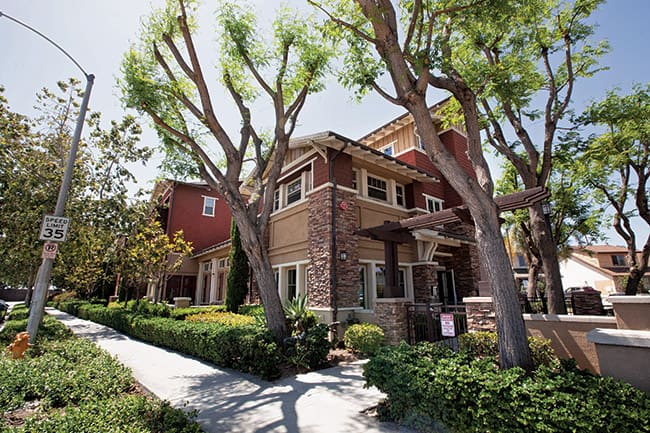Jamboree site tour marred by denial of resident access

by Steven Felschundneff | steven@claremont-courier.com
Jamboree Housing Corporation recently gave me a tour of two of its permanent supportive housing projects, as a preview of what the company has planned for Claremont.
The main reason for my visit was to chat with some of the people who live there, to give Claremont residents a human face or two to accompany the numbers and statistics Jamboree has presented so far.
Jamboree has made the tours widely available but has received tepid response from Claremont residents, so it seemed appropriate that the COURIER provide a firsthand glimpse. Offered a list of housing projects similar to Larkin Place, I selected Diamond Aisle and Buena Esperanza, both in Anaheim.
On June 6, I connected with Director of Marketing and Communications Marissa Feliciano about scheduling the tour. During our conversation, conducted via both phone and email, I requested the opportunity to speak with some of the people who live at the properties.
“Let’s chat once more prior to the tour since you are planning to interview a resident. There are some sensitivities to be observed and it would be great to discuss in advance. If you can please send your questions for the resident in advance, that would be much appreciated,” Feliciano replied in an email.
I agreed that appropriate care and respect were absolutely necessary but responded that submitting questions in advance contradicted the very core of Jamboree’s messaging about permanent supportive housing being a home where the residents become part of the community like anyone else.
“So if a person gives me permission to speak with them why should Jamboree be the gatekeeper on what gets asked? Any person I interview would be an adult with all the same rights as any other citizen,” read my emailed response.
“Absolutely, that is the case,” Feliciano responded, but explained, “Some residents are working through varying levels of trauma, we also want to inform visitors how to be sensitive of what words might be triggers. It’s not an attempt to control or be the gatekeeper of anything. We want to be respectful of what residents are battling, and educate visitors on how to navigate that appropriately.”
While I still felt it was not their place to play middleman, two days prior to my tour, I emailed Feliciano a range of questions I wanted to ask. She responded with a note of thanks and copied Kelsey Brewer, senior director, business development and government relations.
On Friday, I drove to Anaheim to tour the properties. I was scheduled to meet with Brewer, and Director of Supportive Services Danielle Latteri, but was surprised to find Chief Development Officer Michael Massie in attendance as well.
The tour started at Diamond Aisle, Jamboree’s oldest permanent supportive housing project, where a handful of children in the playground stopped briefly to inspect the stranger with the cameras.
The three-story building is well kept inside and out, with new-looking paint and carpet. The project resembles typical urban apartment complexes, a point Jamboree has stressed from the beginning.
We saw a vacant two-bedroom unit that was light and airy with a large living room connected to the kitchen. Carpets in the bedrooms looked new and the appliances were older but well kept. The laminate counter tops had some buckling but Massie said they now use stone counters for this reason. Units come furnished and the selection of couches, chairs and tables looked stylish and in good shape.
The unit I toured had good sound protection from the nearby 5 Freeway, including new double-pane windows.
While Diamond Aisle is the oldest PSH project under Jamboree’s care, Buena Esperanza is among the newest, and the team highlighted the improvements incorporated after years of experience with such developments.
Buena Esperanza is a motel conversion, so all the rooms are studios, each with its own physical key and a doorbell, which Brewer said was her favorite detail. The complex includes a large community room with ample space for meetings and even a billiards table. A selection of fresh and boxed food was available for residents to take home.
Security was good, with self locking doors, ample cameras and lighting. At Buena Esperanza an eye-level wall closes off the open end of the compound and requires a key fob for entry. The same fob gets one into the other common areas at the development.
Overall, the buildings seemed just as Jamboree had promised Larkin Place would be — clean, well maintained and secure. Staff were professional and appeared to truly care about their work. Most important, there were no signs of sketchy individuals hanging around outside the complex, a chief concern of those who oppose Larkin Place.
Twenty-nine people currently live at Diamond and 71 at Buena Esperanza, so with the two vacant units eliminated from the calculation, that equals roughly 1.1 people per unit on average.
When I inquired about speaking with a resident, Latteri informed me that no one she approached agreed to the interview. This announcement caught me completely by surprise because no one from Jamboree said anything about the interview being in jeopardy, despite the fact that I had been in contact with Feliciano and Brewer the day before.
I suggested that we enter the courtyard and attempt to find a willing resident, but was told that would violate the agreement Jamboree has with its residents that it will not surprise them with such requests. However, a few minutes later I was told that maybe the residents didn’t want to be interviewed because of a recent door-to-door survey.
I will take the Jamboree team at their word that connecting with a willing interview subject was not possible in the timeframe presented. However, that simply does not jibe with my decades of experience in the news business. Across this country, and even in terrible moments of crisis, I have found people to be generally open to talking, and mostly on the record.
“As we work with a vulnerable population, Jamboree has a protocol that we follow when asking residents to participate in interviews. Out of respect for our residents, we do not approach individuals to participate in interviews without following our protocol,” Feliciano said.
One would hope that out of professional courtesy they would have called the morning of the tour to give me the option of rescheduling until a resident interview could be arranged. On Monday, when I requested a clarification, I received the following response.
“Our service team was still working to find someone in time for your interview, including right up until the time of your tour last Friday. Unfortunately, no residents were willing to participate in an interview,” Feliciano said.
“Given your original request, we were able to proceed on the site tours with you and will continue to reach out to residents to try to identify a resident to agree to an interview in the next few weeks. We will continue to do our best with outreach but cannot guarantee an interview.”
Now, I understand about protocols and company policy, but the decision makers at Jamboree really should have considered how this would look to people outside of the corporate boardroom. Specifically, people in Claremont who might be on the fence about Larkin Place.
The biggest shame of the whole situation is that many Claremont residents will come to the conclusion that Jamboree is hiding something, even though the housing itself was exactly as promised, a safe and clean looking place to live.
1 Comment
Submit a Comment
You must be logged in to post a comment.










It’s too bad that you weren’t able to interview a resident. Have you considered interviewing the Mayor of Milpitas? I believe he’s been open to sharing his experience dealing with the PSH site there.
Would be an interesting perspective as I know there’s been quite a bit of controversy there over Jamboree’s PSH, Hillview Court.